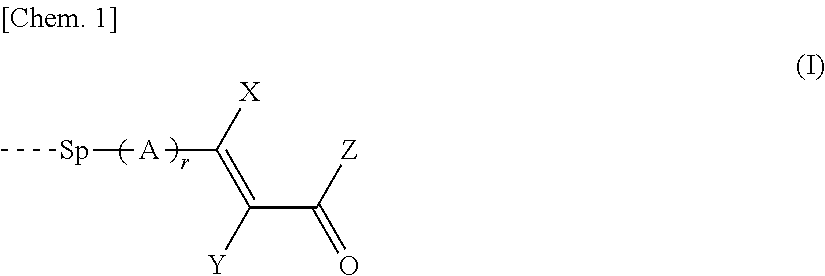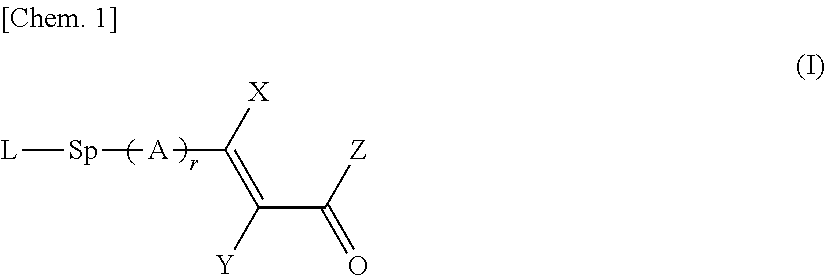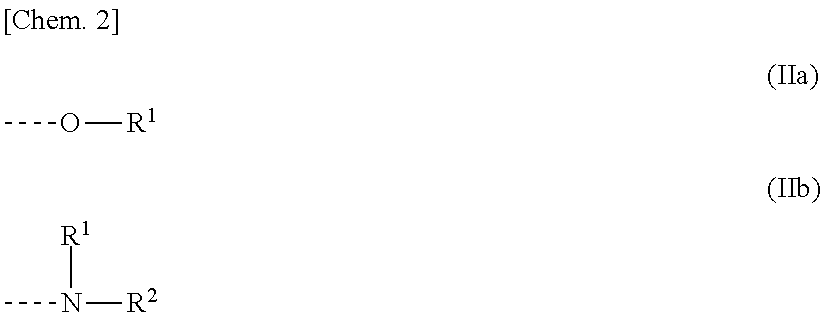Copolymer, and liquid crystal alignment layer including cured product thereof
a liquid crystal alignment and copolymer technology, applied in the field of polymer, can solve the problems of reducing display luminance, affecting unable to control the alignment of liquid crystal molecules, etc., and achieves the effect of superior ability to control the alignment, efficient alignment property, and high voltage holding ratio
- Summary
- Abstract
- Description
- Claims
- Application Information
AI Technical Summary
Benefits of technology
Problems solved by technology
Method used
Image
Examples
example 1
[0428]0.34 parts (0.5 mmol) of a compound represented by the formula (P-1), and 9.66 (9.5 mmol) of a compound represented by the formula (Cinv-1) were dissolved in 10 parts of ethyl methyl ketone to give a solution 1, and 0.01 parts of azobisisobutyronitrile (AIBN) was added to the solution 1. The mixture was heated and refluxed for 2 days under a nitrogen atmosphere to give a solution 2. Next, the solution 2 was added dropwise to 60 parts of methanol under stirring, and the precipitated solid was filtered. The obtained solid was dissolved in 5 parts of tetrahydrofuran (THF), 120 parts of ice-cooled hexane was added dropwise thereto under stirring, and the precipitated solid was filtered. The obtained solid was dissolved in 5 parts of THF, added dropwise to 120 parts of ice-cooled methanol under stirring, and the precipitated solid was filtered. The obtained solid was dissolved in THF and dried under vacuum to obtain a copolymer (ACv-1).
[0429](Preparation of Copolymers (ACv-2) to (A...
example 15
[0440]The copolymer (ACv-1) was dissolved in cyclopentanone to be 0.8% and the solution was stirred at room temperature for 10 minutes. Then, the solution was applied onto a glass plate as a substrate at 2000 rpm for 30 seconds, using a spin coater, and dried at 100° C. for 3 minutes. Then, the surface was visually observed and as a result, it was found that a polymer was uniformly applied on the glass plate to form a smooth film.
[0441]Next, irradiation of linear polarized and parallel light of visible ultraviolet light (wavelength: 365 nm, irradiation intensity: 10 mW / cm2) was performed onto the coated glass plate as a substrate using an ultrahigh-pressure mercury lamp via a wavelength cut filter, a band-pass filter, and a polarizing filter in a direction of 45 degrees with respect to the substrate. The irradiation dose was 100 mJ / cm2.
[0442]A liquid crystal cell was fabricated by using the coated glass plate prepared by the method above. The gap between the plates was set to 10 μm ...
example 29
[0478]The copolymer (ACv-1) was dissolved in N-methylpyrrolidone (NMP) to be 0.5%, and the solution was stirred at room temperature for 10 minutes. The solution was then applied to a glass plate serving as a substrate by using a spin coater and dried at 100° C. for 30 minutes.
[0479]Next, irradiation of linear polarized and parallel light of visible ultraviolet light (wavelength: 365 nm, irradiation intensity: 20 mW / cm2) was performed onto the coated glass plate as a substrate using an ultrahigh-pressure mercury lamp via a wavelength cut filter, a band-pass filter, and a polarizing filter in a direction of 45 degrees with respect to the substrate. The irradiation dose was 90 mJ / cm2.
[0480]The polymerizable liquid crystal composition (LC-1) was applied onto the obtained alignment layer, using a spin coater, and dried at 80° C. for 1 minute. Then, (LC-1) was polymerized by irradiation of ultraviolet rays at 1 J / cm2 under a nitrogen atmosphere to obtain an optical anisotropic body.
[0481]...
PUM
| Property | Measurement | Unit |
|---|---|---|
| pretilt angle | aaaaa | aaaaa |
| pretilt angle | aaaaa | aaaaa |
| temperature | aaaaa | aaaaa |
Abstract
Description
Claims
Application Information
 Login to View More
Login to View More - R&D
- Intellectual Property
- Life Sciences
- Materials
- Tech Scout
- Unparalleled Data Quality
- Higher Quality Content
- 60% Fewer Hallucinations
Browse by: Latest US Patents, China's latest patents, Technical Efficacy Thesaurus, Application Domain, Technology Topic, Popular Technical Reports.
© 2025 PatSnap. All rights reserved.Legal|Privacy policy|Modern Slavery Act Transparency Statement|Sitemap|About US| Contact US: help@patsnap.com



